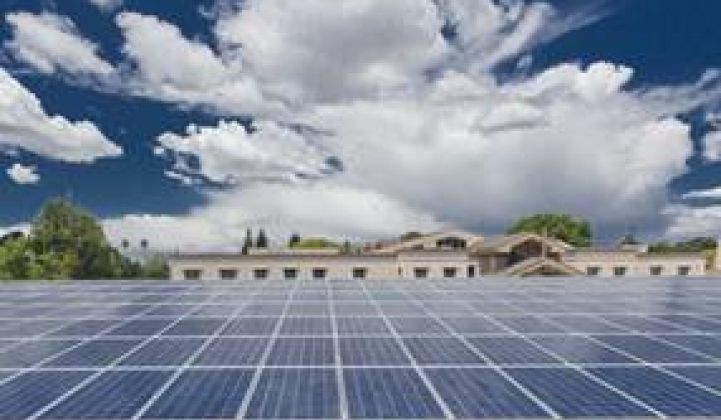Schools and houses of worship can’t make use of the 30 percent federal investment tax credit (ITC) to buy into solar because they don’t pay taxes.
“The only way they can leverage the ITC is if they entered into a power purchase agreement rather than own it themselves,” explained SunPower Managing Director Bill Kelly. But even lower-cost financing can be available to school districts under public ownership models so that “it is cost-effective to forego the ITC.”
Third-party financing of rooftop solar has tripled in California in the last year. As GTM has reported, institutions like Citi, Credit Suisse, Morgan Stanley, Wells Fargo, and U.S. Bank are buying in at the rate of hundreds of millions of dollars.
Power Purchase Agreement (PPA) and lease finance models are transforming the solar industry. The institutional investors get tax equity opportunities and a revenue stream for providing the upfront financing. Homeowners, business owners and public entities get solar-generated electricity at a guaranteed, long-term rate discounted from their present utility bill pricing without the burden of upfront cost or ownership responsibilities.
And companies like SolarCity, Sunrun, Sungevity, and Clean Power Finance and/or their solar-installer representatives get a fee or a part of the revenue stream for the system installation and maintenance.
There are also three or four public ownership models available to public agencies, Kelly said. Schools can “own the system themselves and borrow funding.” They can choose either a General Obligation (GO) bond or one of three subsidized bonds.
_540_449_80.jpg)
Qualified School Consolidation Bonds (QSCBs) are available through the U.S. Department of Education. Qualified Energy Consolidation Bonds (QECBs) and Clean Renewable Energy Bonds (CREBs) are available through the U.S. Department of Energy.
“We don’t have an outright preference,” Kelly said. “We’re looking at the school district and finding what the best economic value for them is and recommending either a PPA or public ownership. If public ownership is the best option,” he explained, “then we’re looking for the lowest cost of financing within those choices.”
SunPower has been working with school districts for a few years, Kelly said, honing its skill at identifying that best option. “It can make a significant difference in the savings.”
Each school district is different. They vary in borrowing capacity. They may or may not be in a position to take a GO bond to their electorate, as the City of Lancaster, California, did recently.
Once Lancaster’s voters approved a $27 million bond at a 4.4 percent return, two school districts got 7.5 megawatts of solar at 25 sites and $325,000 or more in annual electricity bill savings for 25 years.
The other bonds make sense when a GO bond is not an option. SunPower recently worked with California's San Ramon Valley Unified School District to put 3.5 megawatts on five high schools through a QSCB at a very low 1 percent to 2 percent interest rate. The total system cost for SunPower to build carports and install panels and trackers on top of them was $26 million.
The bonds were ultimately backed by a bank or an investor, Kelly noted. “Subtracting out the cost of the system,” Kelly said, “the net savings come to $13 million over twenty years.” SunPower, he added, handles all system maintenance and operations responsibilities.

Because its website uses SunPower’s online tools to track every detail of the system, the San Ramon Valley School District and its taxpayers know the savings, from October 2011 to July 2012, are $1.8 million, according to Kelly. That is just about the length of a school year, and the salaries of a lot of decently reimbursed teachers, Kelly acknowledged.
Kelly estimates the solar systems installed or being installed on schools under the California Solar Initiative (CSI), former Governor Arnold Schwarzenegger’s “million solar roofs” program, will save the state’s schools $1.5 billion over the next 30 years.
That, however, is only about 5 percent to 10 percent of the state’s schools, Kelly said. He estimates the potential savings for education at $15 billion to $30 billion.
Other public agencies use electricity, too. Excluding federal properties, Kelly said, school districts represent only about half the potential. There also cities, counties, transit authorities, water districts, and other possibilities.
Sun Light & Power CEO Gary Gerber is about to close a third-party-financed deal to put a twenty-kilowatt solar system on a house of worship but, in a creative twist, the third party is the church’s congregation. It's known as crowdfunding.
Special Purpose Entities, in the form of LLCs, Gerber said, can sell memberships to supporters of non-profit organizations like Boys and Girls Clubs, YMCAs, food co-ops and churches. Gerber’s $90,900 solar project will be funded by 303 memberships of $300 each.
Like other third-party models, Gerber noted, this one can expect to pay off. Does that mean the church will get new funding as well as electricity? “LLCs must be organized to make a profit,” Gerber said. But, he added, he knows of nothing that dictates what is done with the profit.



